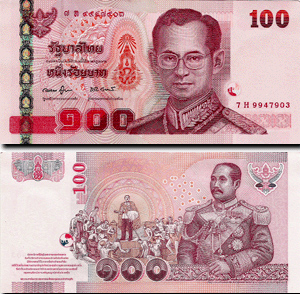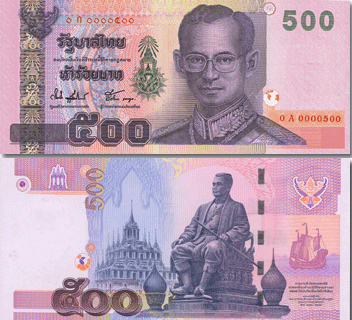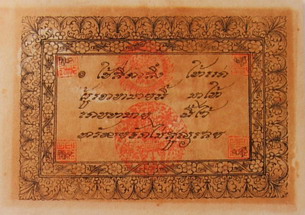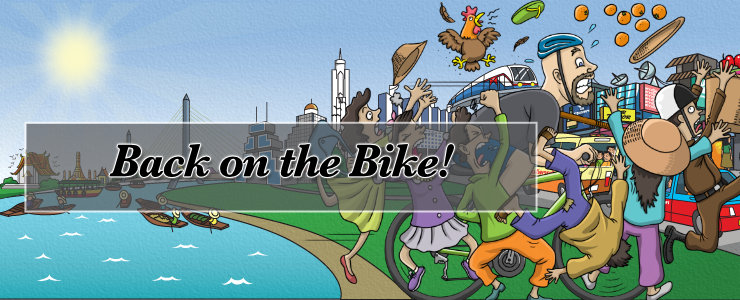I remember the first time I saw a baht. It was about two months before I came to Thailand and I happened to wander by an exchange booth. I’d never seen Thai money before, so I exchanged a few bucks and walked out with a fistfull of crumpled, green 20 baht notes, which was all they had in the shop. I didn’t know who the guy was on the money, or what the weird squiggles meant, but it looked cool. It was actually the first foreign money I’d ever held outside of American dollars. Now, my fingers rifle through literally hundreds of baht a day (that’s right – hundreds) but I rarely stop to think about what it’s all about. So, one day I did; I got curious, sent out a few emails and looked at a few websites, and for no reason than a very niche curiosity, will explain below what exactly is presented on Thai baht.
But first, a quick summary of baht from the hard to navigate but surprisingly comprehensive website of the Bank of Thailand. Back in the day Thais used shells, clay coins, and metal slugs as currency. In 1853, as the industrial revolution, uh…revolutionized and boosted trade, King Rama IV introduced paper currency into Thailand, which started slowly but gained acceptance when several foreign banks were invited to manage its disbursement and circulation. Despite a few decades of activity it remained an unstable business until the Siamese Currency Notes Act was passed in 1902 and the Thai Banknotes Department was created by King Rama V. In 1942, the Bank of Thailand was created and it’s been (relatively) smooth sailing since then.
To get an idea about what’s on the notes, I contacted Owen Linzmayer at BanknoteNews.com to see if he had any info on Thai banknotes. He put me in touch with a gentleman by the name of Sukhprem who was very helpful in responding to my questions. Keep in mind these details are for the most current series of banknotes – the information will be different for older and newer series, when they’re released.
Most Thai banknotes share a few similar icons – the ‘winged birdman’ is the Garuda, a creature from Hindu and Buddhist mythology that is the national emblem of Thailand as well as the Royal Standard. You can also see the Royal Cypher of HM the King on every note except the 50 and 1,000 – that’s the stylized Thai letters Bhor Por Ror (ปภร) topped with the royal crown. The ‘Bhor’ is the first letter in HM the King’s name, Bhumiphol, while the ‘Por Ror’ stands for ‘Porama Rajathiraj’, a royal standard similar to the ‘Rex/Regina’ for the male/female British monarch, Sukhprem told me. The little squiggle between the letters and the crown is the unalom, the Thai version of the Aum, an ancient Hindu religious symbol. On the left side of the note you also have Thai writing that says ‘Ratabaan Thai’ (Thai Government) and then the note’s denomination spelled out below it.
Anyway, first, the 20 baht note.

The front is pretty straight forward – it’s got ’20’ in both Thai and Arabic numerals, and of course a portrait of HM the King in the uniform of Supreme Commander, as well as various little design flairs and security features.
The back of the note shows King Rama VIII (1925-1946), the current King’s brother, standing in front of the Rama VIII bridge, with the smaller picture detailing a visit to Chinatown’s Sampeng Lane by Rama VIII (on the right) and Rama IX (on the left). On the upper left of the note is King Rama VIII’s personal cypher.
Next we have the 50 baht note. This one is actually my favorite – it’s a bit rarer than the 20s or 100s. It also comes in handy most often in taxis, as the meter for an average trip (for me) is often 49 or 69 baht or thereabouts.

On the front you again have the Garuda, plus the Thai and Arabic numerals for 50 as well as a more recent picture of HM the King wearing the formal gown of the Chakri Dynasty. The red writing only appears on non-circulating notes given as gifts and samples, and says “specimen”.
On the back is a statue of King Naresuan, who ruled the Ayutthaya Kingdom from 1590-1605 and known for his frequent epic scraps with the Burmese. He is pouring water on the ground, signifying the independence of his Kingdom. The smaller picture on the left is the King on his war elephant storming into battle with his sword drawn, and a few Burmese warriors falling off of a castle wall in the middle of battle.
Now the 100 baht note.

“Big red”, as I call it, again has a picture of HM the King on the front in the uniform of Supreme Commander, the Royal Cypher, Garuda, etc.
On the back is a portrait of Rama V, aka King Chulalongkorn (1853-1910), in the uniform of Admiral of the Fleet. The picture to his right is an image of a cremony in which King Rama V abolished Corvee. In the west it would simply be known as slavery, but the Thai corvee system at time was more complex and tied to complicated social and economic strata in a rapidly evolving society. Anyway, he was the one who essentially got rid of it, but it’s worth reading about, as it was an important turning point in the development of modern Thailand. On the upper left of the note is King Rama V’s personal cypher.
Up next is the 500 baht note.

Again on the front we have HM the King in the uniform of the Supreme Commander, the Royal Cypher and the Garuda.
The statue on the back is of King Rama III (1787-1851), which his located at the Royal Pavillion on Ratchadamnoen Avenue, and to his right is a picture of Loha Prasart (the Steel Citadel) at Wat Ratchanadda on Ratchadamnoen Avenue, which is topped with 37 spires that represent the Bodhipak Khiyadhamma, the 37 virtues leading to enlightenment. The boat on the right hand side is a Chinese junk, which signifies the increase in trade between China and Siam during his reign. On the top left you can see the personal cypher for King Rama III.
And finally…

The big daddy in the family is the 1,000 baht note, which has similar features on the front as the previous few notes. The one notable change is the different cypher, which – as near as I’m able to divine from limited info online – is HM the King’s personal cypher rather than that of the royal family.
On the back of the note is a picture of HM the King (with his trusty camera and map) inspecting Pa Sak Jolasid Dam, which is part of an agricultural plan inspired by the King’s ‘Suffciency Theory‘ of commodity management. The little portrait on the right shows a family tending their buffalo, gathering fruit and harvesting rice, further illustrating the sufficiency theory concept.
So there you go, a quick rundown on what’s on Thai paper money. Maybe in a future blog I’ll write about the coins. The irony is, of course, that I have more of the latter than the former, but we always write about the things we want more of, heh.






Thanks for all the work you put into chasing this up Greg. Its really fascinating. I'd love to know why so many of the notes are pink. Coming from a country where all notes are instantly recognisable by color I find it sometimes makes it difficult in a taxi on a dark night.
Great blog post, Greg! Thanks:)
Glad you liked it!
Do you know why/how Hinduism has affected the currency?
Hi Spike. Thai culture is a mix of Hindu, Buddhist, Animist, and other regional religions and cultures, which finds its way into many parts of the culture. We talked about it more on this episode of the podcast: http://www.bangkokpodcast.com/holy-cow-the-role-of-hindu-priests-in-buddhist-thailands-royal-court-2-45/